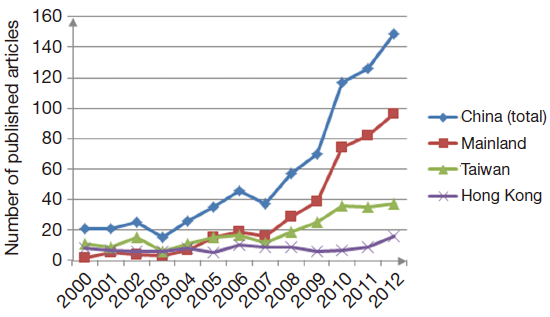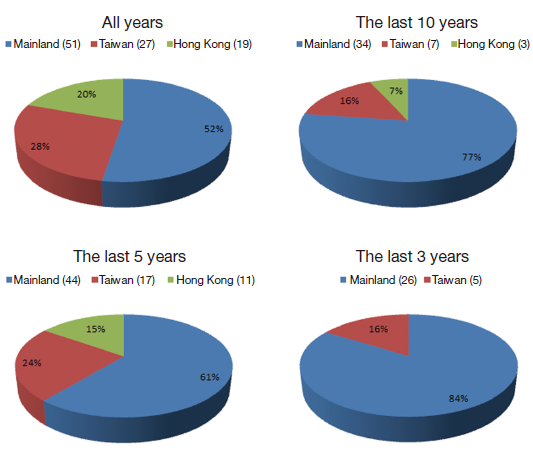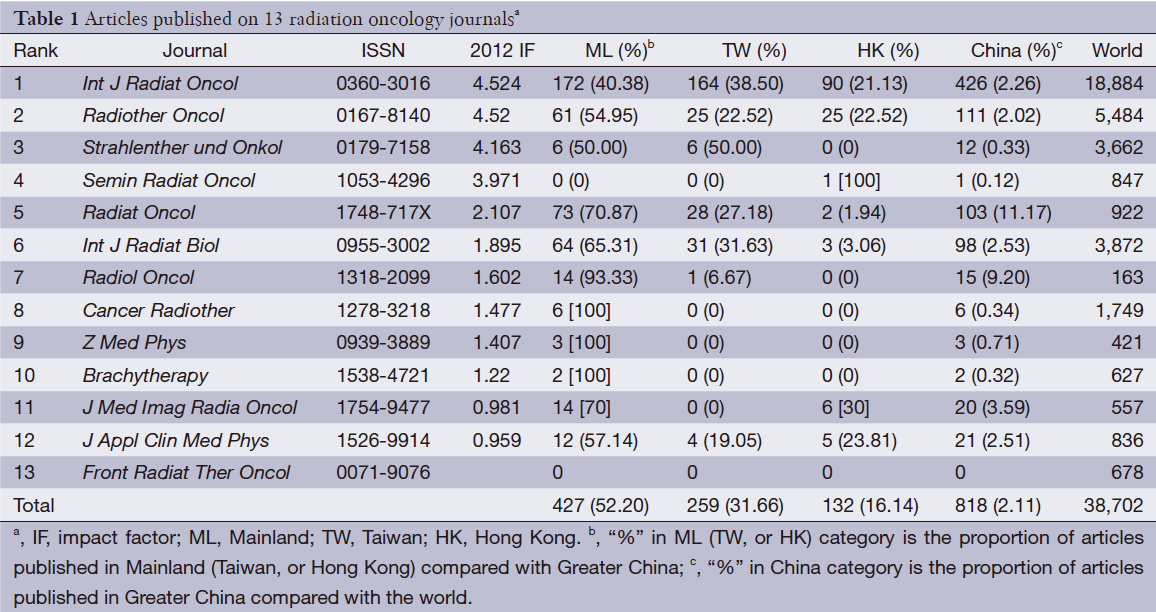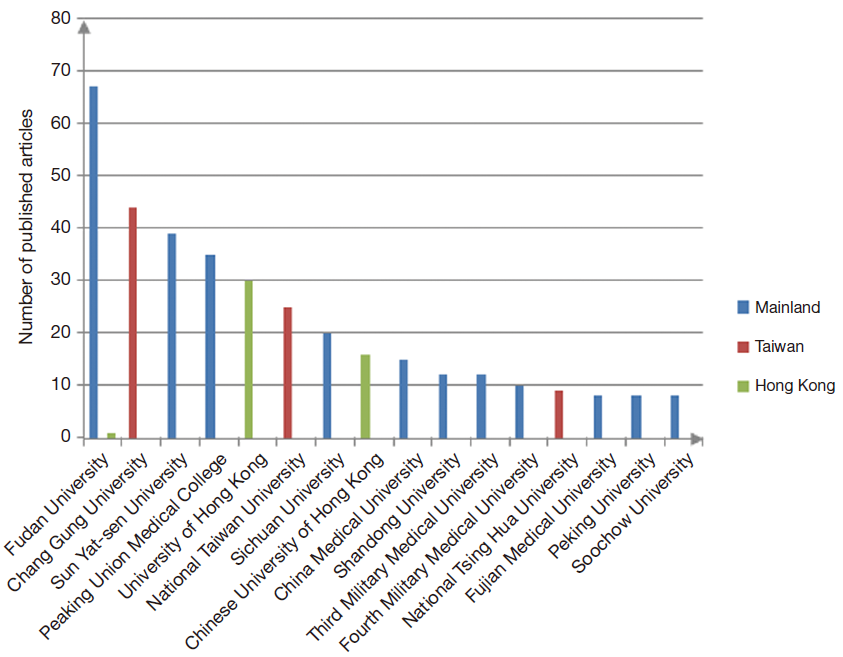Report of China’s innovation increase and research growth in radiation oncology
Introduction
People of Chinese ethnicity are one of the most high-risk groups of cancer in the world, with an incidence rate of 285.91/100,000 (317.97/100,000 in males and 253.09/100,000 in females) and mortality rate of 180.54/100,000 (224.20/100,000 in males and 135.85/100,000 in females) by the Chinese National Central Cancer Registry (NCCR) (1). Although it was suggested that China ranked the second of papers published in journals of Science Citation Index Expanded (SCIE) (2), the scientific publications in the field of radiation oncology by Chinese authors were not reported. Also, this is the 27th year from the establishment of the Chinese Society of Therapeutic Radiology and Oncology, and radiation oncology has grown remarkably in last decades, especially the advanced techniques have been implemented very quickly (3). In order to more comprehensive understanding of radiation oncology development in China, we therefore intended to reveal the contribution of Chinese authors in major regions of China—the Mainland (ML), Hong Kong (HK) and Taiwan (TW)—to the research published in international radiation oncology journals.
Methods and materials
Journal selection
Journals in the field of radiation oncology were selected from “oncology” and “radiology, nuclear medicine & medical image” journal list of SCIE by the Institute for Scientific Information (ISI) (4). The journals included are mostly dealing with radiation biology, clinical investigation, medical physics and et al. of cancer. Comprehensive cancer journals (such as Journal of Clinical Oncology, Cancer Research, Lung Cancer and et al.) and general medicine journals (such as The New England Journal of Medicine, Journal of American Medical Association, The Lancet, and et al.) which may partly publish articles about chemoradiation or radiation therapy were not included in this study.
Search strategy and quality assessment
A computerized literature search was conducted in MEDLINE (PubMed, http://www.ncbi.nlm.nih.gov/pubmed/) from their inception to August 10, 2013 by two independent reviewers (Hongcheng Zhu and Xi Yang) (5). The ISSN (Print), first author’s affiliation (ML, TW, HK), article types (clinical trials, case reports, and et al.), publication dates were used to perform searches in PubMed. China in this article is considered as the Greater China, covering ML, TW and HK. And the search terms of ML is “China” [ad] NOT “Hong Kong” [ad] NOT “Taiwan” [ad]. Accumulated impact factor (IF) and the average IF were generated according to Journal Citation Reports (JCR) 2012 by the ISI (6).
Statistical analysis
STATA (version 11.0; StataCorp, College Station, Texas, USA) was used to perform the statistical analysis. The test for significance was two-tailed and the value of P<0.05 was considered significant. The nonparametric test for trend was performed to determine change of the total numbers over time. Kruskal-Wallis test was used for detecting the difference among regions, and rank-sum test between two when necessary.
Results
Journals included
A total of 13 journals from 203 “oncology” journals and 122 “radiology, nuclear medicine & medical imagine” journals of SCIE were eventually included in this study. The list is as described in Table 1. Two potential journals: Cancer Biotherapy and Radiopharmaceuticals, ISSN: 1084-9785, IF =1.738; and Medical Physics, ISSN: 0094-2405, IF =2.911; were excluded after further discussion because many articles published are not in the field of radiation oncology.
Total number of articles and trends
A total of 38,702 articles are published in the 13 radiation oncology journals worldwide, 818 (818/38,702, 2.11%) of which are contributed by Chinese authors as the first affiliation. There are 427 (427/818, 52.20%) from ML, 259 (259/818, 31.66%) from TW, and 132 (132/818, 16.14%) from HK. The share of Chinese articles has grown in the last 10 years (644/17,746, 3.63%), 5 years (499/11,182, 4.46%), and 3 years (398/7,853, 5.07%). The number of articles increased significantly since 2000 in China (from 21 to 149, P<0.001) as well as the two main regions (ML: from 2 to 96, P<0.001; TW: from 11 to 37, P<0.001), but not in HK (from 8 to 16, P=0.068) (Figure 1).

Clinical trials and case reports
There were 4,116 clinical trials published in the 13 journals, 97 of which are by Chinese authors (97/4,116, 2.36%). The share is stable in the last 10 years (72/2,216, 3.25%), the last 5 years (44/1,240, 3.55%), and the last 3 years (31/815, 3.80%). The share of ML is significantly increased, with decrease of both TW and HK through all years (ML: 51/97, 52.58%; TW: 27/97, 27.84%; HK: 19/97, 19.59%), the last 10 years (ML: 44/72, 61.11%; TW:17/72, 23.61%; HK: 11/72, 15.28%), the last 5 years (ML: 34/44, 77.27%; TW: 7/44, 15.91%; HK: 3/44, 6.82%), and the last 3 years (ML: 26/31, 83.87%; TW: 5/31, 16.13%; HK: 0/31, 0%) (Figure 2).

Interestingly enough, only 5 (3 from ML, and 2 from TW) of all 798 case reports are published by Chinese authors in our search terms, 4 of which are in the last 3 years.
Impact factors (IF)
According to JCR 2012, all of the 13 radiation oncology journals, excepting Front Radiat Ther Oncol, had IF in 2012 (6). The accumulated and average IF of all the articles published in the 12 journals is 2,964.914 and 3.625. It was expected that the accumulated IF of articles from ML (1,417.11) was much higher than that of TW (1,003.093) and HK (544.711), while the average IF of articles from ML is the lowest (ML: 3.319, TW: 3.873, HK: 4.127).
Interestingly enough, the average IF of articles from China has declined in the last 10 years (total China: 3.502, ML: 3.257, TW: 3.839, HK: 3.851), the last 5 years (total China: 3.297, ML: 3.127, TW: 3.652, HK: 3.435), and in the last 3 years (total China: 3.132, ML: 2.964, TW: 3.544, HK: 3.189) (P<0.001).
Articles published on radiation oncology journals
The top-ranking radiation oncology journals are the Red journal (International Journal of Radiation Oncology Biology Physics, IF =4.524) and the Green journal (Radiotherapy and Oncology, IF =4.52), which are with great reputation among radiation oncologists both in China and the rest of the world. China accounted for 2.26% and 2.02% of articles on the two journals. ML published 172 articles on the Red journal and 61 articles on the Green journal, while TW had 164 on the Red journal and 25 on the Green journal and HK had 90 on the Red journal and 25 on the Green journal, respectively.
The most popular journals among Chinese authors are the Red journal (with No. 1 number of articles: 426) and Radiation Oncology (with No. 1 percentage of articles: 11.17%). The Red journal is also most popular in TW and HK with the most published articles. And Radiation Oncology had more articles from ML (70.87%) than TW (27.18%) and HK (1.94%) compared with other journals (P<0.001). The distribution of articles published in the 13 radiation oncology journals was listed in Table 1.

Full table
Well-done organizations
When searching by affiliations, we identified 16 major organizations of universities with more than 8 articles published in the 13 journals. The top-16 organizations by articles cover 11 from ML (Figure 3). Other organizations with less than 8 articles published were not considered. Fudan University ranked No. 1 in ML and China of articles published in the 13 radiation oncology journals, and Chang Gung University and The University of Hong Kong are on the top in TW and HK. The details are listed in Figure 3. Other organizations with less than 8 articles published were not presented.
Discussion
To our knowledge, this is the first report to reveal the contribution of authors in China including ML, TW, and HK to the research in international radiation oncology journals. Our findings indicated that China, especially ML has improved the research in radiation oncology field in the 21th century gradually, and the articles published in major international radiation oncology journals has increased in the last decade.
China’s economy has grown rapidly and become the second in the world after the United States (7). Problems of population aging, decreased exercise, tobacco and alcohol abuse, environmental pollution, food safety, et al. occur, which cause problems both socially and medically. All of these contribute to the increase of diabetes, cardiovascular disease as well as cancer in Chinese population, which is a price that developing countries must pay for modernization. However, letting the price the Chinese pay not exceed the benefits from modernization is what we must make efforts for (8).
It is believed that radiation therapy is one of the three major ways to treat cancer and 65% to 75% of admitted patients should be treated with radiotherapy. However, only one third of patients in need received the treatment (3). Advanced radiotherapy systems such as TOMO Therapy, Intensity Modulated ARC Therapy (V-MAT), Imagine Guide Radiation Therapy (IGRT), Intensity Modulated Radiation Therapy (IMRT), 3-Dimensional Conformal Radiation Therapy (3D CRT), and et al. are available in major oncology centers in China nowadays. And, even porton therapy has been implemented. Chinese government and people realize the important roles radiation therapy pays to treat cancer and are making efforts for the development of radiation oncology (9).
The articles in this study were retrieved using the computer generated search from MEDILINE and JCR, which are both recognized database, containing high-quality scientific literature and major biomedical journals. It also should be mentioned here that although IF is not the optimal parameter for determining the quality of articles, since even the high-IF journals may sometimes publish poor-quality articles, it is the best available parameter for determining the quality of studies at present anyway.
In our study, we evaluate the radiation oncology development of China from the perspective of published research and compare the three main regions. Both total numbers and proportion of the articles published in radiation oncology journals have increased in the last decade. The number of articles published from ML exceeded that from HK in 2005 and in 2006 ML exceeded TW. When IF and articles published in top radiation oncology journals were conducted for quality comparisons, the gap of radiation oncology research articles among ML, TW and HK was still appears to be considerable. HK had the highest average IF of 4.127, and followed by TW of 3.873, ML of 3.319. HK and TW have been for many years been at the forefront of scientific and medical research, and investigations from these regions having contributed some of the best scientific papers in radiation oncology.
The proportion of clinical trials from ML has increased in the last 10 years with which of TW and HK both decreased. There are several reasons: first, ML is making more efforts for high-quality clinical investigation these years and the contribution are growing rapidly; second, ML has a population of 1.4 billion and clinical trials in China are much cheaper and easier to conduct (10).
There are some limitations in our study. Although the journals were selected from “oncology” and “radiology, nuclear & medical image” category from SCIE, a few journals may cover resources beyond radiation oncology, and some articles published in comprehensive cancer journals, general medicine journals, and other kinds of medical journals are not included in this study. We also limited the author’s affiliation by (China, HK or TW), and the articles that only addressed particular Chinese cities or provinces were not included. In fact, there was also Macau included in our study in our previous design. But we later excluded it when we found there were few articles affiliated to it. So there were only three regions in our study, which can also reflect the actuality of the research on radiation oncology in the whole Greater China. Besides, when searching by affiliations, using University may have caused some missing data, as some authors in China do not list University in their publication, and some cancer centers may have confused affiliations with universities.
Conclusions
The number of articles published in radiation oncology journals from ML, TW, and HK increased significantly during the last decade gradually, and the contribution by Chinese authors in radiation oncology has grown. However, the quality of articles from HK and TW is better than that from ML, though the number of articles published from the ML have exceeded those from TW and HK.
Acknowledgements
Funding: This work was supported by the Research and Innovation Project for College Graduates of Jiangsu Province (No. CXZZ12_0588), Natural Science Foundation of China (No. 81272504), Innovation Team [No. LJ201123 (EH11)], A Project Funded by the Priority Academic Program Development of Jiangsu Higher Education Institutions (PAPD) (JX10231801), grants from Key Academic Discipline of Jiangsu Province “Medical Aspects of Specific Environments”, Six Major Talent Peak Project of Jiangsu Province (2013-WSN-040), Jiangsu Provincial Science and Technology Projects [BK2011854 (DA11)], and “333” Project of Jiangsu Province [BRA2012210 (RS12)].
Disclosure: The authors declare no conflict of interest.
References
- Chen W, Zheng R, Zhang S, et al. Report of incidence and mortality in China cancer registries, 2009. Chin J Cancer Res 2013;25:10-21. [PubMed]
- Statistics results of Chinese scientific papers published 2012. Cited 4 August 2013. Available online: http://www.istic.ac.cn/ScienceEvaluateArticalShow.aspx?ArticleID=94467
- Yin W, Chen B, Tian F, et al. The growth of radiation oncology in mainland China during the last 10 years. Int J Radiat Oncol Biol Phys 2008;70:795-8. [PubMed]
- Journal search: Science citation index expanded subject categories. Cited 4 August 2013. Available online: http://science.thomsonreuters.com/cgi-bin/jrnlst/jlsubcatg.cgi?PC=D
- PubMed. Cited 4 August 2013. Available online: http://www.ncbi.nlm.nih.gov/pubmed
- ISI Journal Citation Reports, Institute for Scientific Information, 2012. Cited 4 August 2013. Available online: http://isiknowledge.com
- Li X, Zhang W. The impacts of health insurance on health care utilization among the older people in China. Soc Sci Med 2013;85:59-65. [PubMed]
- Cheng TO. Price of modernization of China. Circulation 2001;103:E131-3. [PubMed]
- He J, Chen W. eds. Chinese Cancer Registry Annual Report 2012 by National Cancer Center & Disease Prevention and Control Bureau, Ministry of Health. Beijing: Military Medical Science Press, 2012.
- Mervis J. Epidemiology. China’s unique environment favors large intervention trials. Science 1995;270:1149-51. [PubMed]

